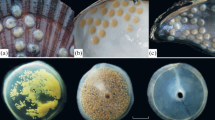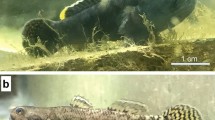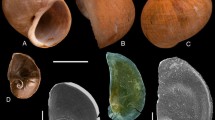Abstract
Larval release, hatching rhythms and moult patterns were examined in a captive population of the subantarctic lithodid, Paralomis spinosissima from the South Georgia and Shag Rocks region. Larvae hatched throughout the year with the majority of females starting to release larvae at the end of the austral summer and beginning of autumn. Larval release continued over a period of up to 9 weeks with high variability in the numbers that hatched each day. A similar seasonal pattern to hatching was evident in the moulting of females. Intermoult period for two adult females (CL = 63 and 85 mm) ranged from 894 to 1,120 days while an intermoult period for males was estimated to be in excess of 832 days. The results are consistent with other species of Paralomis and are discussed in relation to physiological and environmental adaptations to the cold-water conditions south of the Antarctic Convergence.



Similar content being viewed by others
References
Agnew DJ (2004) Fishing South. The history and management of South Georgia fisheries. Penna, St Albans
Anger K, Thatje S, Lovrich GA, Calcagno JA (2003) Larval and early juvenile development of Paralomis granulosa reared at different temperatures: tolerance of cold and food limitation in a lithodid crab from high latitudes. Mar Ecol Prog Ser 253:243–251
Anger K, Lovrich GA, Thatje S, Calcagno JA (2004) Larval and early juvenile development of Lithodes santolla (Molina, 1782) (Decapoda: Anomura: Lithodidae) reared at different temperatures in the laboratory. J Exp Mar Biol Ecol 306:217–230
Baeza JA, Fernandez M (2002) Active brood care in Cancer setosus (Crustacea: Decapoda): the relationship between female behaviour, embryo oxygen consumption and the cost of brooding. Funct Ecol 16:241–251
Calcagno JA, Lovrich GA, Thatje S, Nettelmann U, Anger K (2005) First year growth in the lithodids Lithodes santolla and Paralomis granulosa reared at different temperatures. J Sea Res 54:221–230
Collins MA, Yau C, Guilfoye F, Bagley P, Everson I, Priede IG, Agnew D (2002) Assessment of stone crab (Lithodidae) density on the South Georgia slope using baited video cameras. ICES J Mar Sci 59:370–379
Dawson EW (1989) King crabs of the world (Crustacea: Lithodidae) and their fisheries. A comprehensive bibliography. NZ Oceanol Inst Misc Publ 101:338
Frederich M, Sartoris FJ, Pörtner HO (2001) Distribution patterns of decapod crustaceans in polar areas: a result of magnesium regulation? Polar Biol 24:719–723
Hoggarth DD (1993) The life history of the lithodid crab, Paralomis granulosa, in the Falkland Islands. ICES J Mar Sci 50:405–424
Lovrich GA, Vinuesa JH (1993) Reproductive biology of the false southern king crab (Paralomis granulosa, Lithodidae) in the Beagle Channel, Argentina. Fish Bull 91:664–675
Lovrich GA (1997) La pesquería mixta de las centollas Lithodes santolla y Paralomis granulosa (Anomura: Lithodidae) en Tierra del Fuego, Argentina. Invest Mar (Valparaíso) 25:41–57
Lovrich GA, Vinuesa JH (1999) Reproductive potential of the lithodids Lithodes santolla and Paralomis granulosa (Anomura, Decapoda) in the Beagle Channel, Argentina. Sci Mar 63:355–360
Morley SA, Belchier M, Dickson J, Mulvey T (2006) Reproductive strategies of sub-Antarctic lithodid crabs vary with habitat depth. Polar Biol 29:581–584
Otto RS, Macintosh RA (1996) Observations on the biology of the lithodid crab Paralomis spinosissima from the Southern Ocean near South Georgia. In: High latitude crabs: biology, management and economics. Alaska Sea Grant College Progr Rep No 96–02. University Alaska, Fairbanks, pp 627–647
Purves MG, Agnew DJ, Moreno G, Yau C, Pilling G (2003) Distribution, demography, and discard mortality of crabs caught as bycatch in an experimental pot fishery for toothfish (Dissostichus eleginoides) in the South Atlantic. Fish Bull 101:874–888
Sloan NA (1985) Life-history characteristics of fjord-dwelling golden king crab Lithodes aequispina. Mar Ecol Prog Ser 22:219–228
Somerton DA (1981) Contribution to the life history of the deep sea king crab Lithodes couesi, in the Gulf of Alaska. Fish Bull 79:259–269
Stevens BG (2006) Timing and duration of larval hatching for blue king crab Paralithodes platypus Brandt, 1850 held in the laboratory. J Crust Biol 26:495–502
Thatje S (2004) Reproductive trade-offs in benthic decapod crustaceans of high southern latitudes: tolerance of cold and food limitation. Ber Polar Meeresforsch (Rep Polar Mar Res) 483:1–183
Thatje S, Calcagno JA, Lovrich GA, Sartoris FJ, Anger K (2003) Extended hatching periods in the Subantarctic lithodid crabs Lithodes santolla and Paralomis granulosa (Crustacea: Decapoda). Helgol Mar Res 57:110–113
Thatje S, Arntz WE (2004) Antarctic reptant decapods: more than a myth? Polar Biol 27:195–201
Thatje S, Anger K, Calcagno JA, Lovrich GA, Pörtner HO, Arntz WE (2005) Challenging the cold: crabs reconquer the Antarctic. Ecology 86(3):619–625
Watters G (1997) Preliminary analyses of data collected during experimental phases of the 1994/95 and 1995/6 Antarctic crab fishing seasons. CCAMLR Sci 4:141–158
Watts J, Thatje S, Clarke S, Belchier M (2006) A description of larval and early juvenile development in Paralomis spinosissima (Decapoda: Anomura: Paguroidea: Lithodidae) from South Georgia waters (Southern Ocean). Polar Biol 29:581–584
Wenner AM, Fusaro C, Oaten A (1974) Size at onset of sexual maturity and growth rate in crustacean populations. Can J Zool 52:1095–1106
Zaklan SD (2002) Review of the family Lithodidae (Crustacea: Anomura: Paguroidea): Distribution, biology, and fisheries. In: Paul AJ, Dawe EG, Elner R, Jamieson GS, Kruse GH, Otto RS, Sainte-Marie B, Shirley TC, Woodby D (eds) Crabs in cold water regions: biology, management, and economics. University of Alaska Sea Grant College Program AK-SG-02-01, Fairbanks, AK, USA, pp 751–845
Acknowledgments
We would like to thank the biological research teams at King Edward Point, who have kept the crab-rearing programme going for the last 5 years, and to the observers working on South Georgia’s fisheries, for continually bringing us samples. This work was carried out at the British Antarctic Survey, Applied Fisheries Laboratory at King Edward Point, South Georgia, under contract to the Government of South Georgia and the South Sandwich Islands. Thanks are due to Gustavo Lovrich and two anonymous reviewers for their comments on the manuscript.
Author information
Authors and Affiliations
Corresponding author
Rights and permissions
About this article
Cite this article
Reid, W.D.K., Watts, J., Clarke, S. et al. Egg development, hatching rhythm and moult patterns in Paralomis spinosissima (Decapoda: Anomura: Paguroidea: Lithodidae) from South Georgia waters (Southern Ocean). Polar Biol 30, 1213–1218 (2007). https://doi.org/10.1007/s00300-007-0279-x
Received:
Revised:
Accepted:
Published:
Issue Date:
DOI: https://doi.org/10.1007/s00300-007-0279-x




